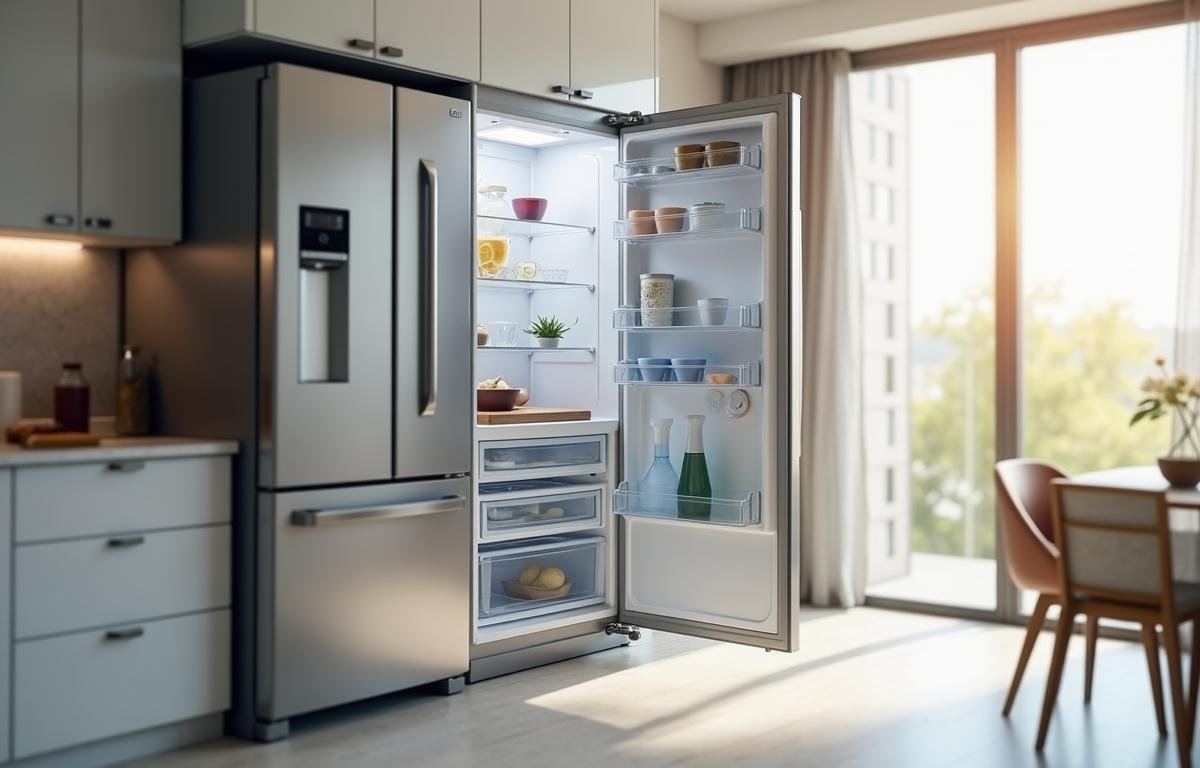When setting up a new fridge, understanding how long it takes to cool down is crucial. Without giving it enough time to settle and reach optimal temperature levels, your groceries might not stay as fresh as you expect. This can lead to wasted food, unexpected odors, and a higher energy bill if you try to compensate by turning the temperature dial too far. It’s essential to strike a balance between patience and preparation so that your food remains safe and the fridge performs at its peak every day.
Many people wonder how long they need to wait before storing perishables, or what factors influence the speed at which the interior cools. What follows is a look into the common elements that affect the process, useful tips on ensuring a smooth start, and a few pointers on maintaining the right temperature over time. By taking these steps, you can keep your perishables fresh and your energy bills in check. It’s all about letting your fridge breathe, monitoring its performance, and making the right choices from the moment you plug it in.
Contents
Key factors that affect fridge cooling times
Several elements come into play when it comes to how quickly your fridge reaches a food-safe temperature. Everything from the size of your appliance to the ambient temperature in your home can speed things up or slow them down. Knowing these factors helps you make small adjustments that can shave off a few hours of waiting.
Size and capacity
Larger fridges hold and circulate more air. This often means it takes a bit longer for the internal temperature to stabilize, especially if you fill the refrigerator with a lot of items right away. A small unit located in a moderate environment might cool down in four to six hours, while a bigger model can take anywhere from eight to twelve hours.
Overloading a fridge hampers the flow of air as well. If you want the best fridge cooling time, resist the urge to stuff every shelf or drawer immediately. Try to leave some space for air circulation during the first day or two. This not only helps everything chill faster but also places less stress on the compressor.
Surrounding room temperature
Whether you place your fridge in a toasty corner of your kitchen or a bright sunroom, the surrounding temperature plays a significant role in how fast the inside cools. If the ambient environment is too hot, the fridge’s motor works harder to remove heat from the compartments. Even a standard-temperature kitchen can impact performance when it’s packed with ovens and stovetops that give off excess heat.
Another point to note is that extreme cold can affect cooling times as well. A garage that drops to near-freezing might trick the fridge’s thermostat, leading it to operate less efficiently. Striking a comfortable indoor climate ensures quick cooling without straining the compressor.
Preparations for faster fridge cooling
A little foresight can shorten the time it takes to reach a safe temperature. The trick is to balance patience with simple tasks that set the stage for success. By doing a few key steps before turning on the machine, you might sidestep common issues and shave off precious hours of waiting.
Leveling and spacing
Proper placement goes beyond avoiding direct sunlight or a scorching corner. Make sure your fridge sits on a level surface. A tilted fridge can prevent the coolant from flowing correctly. Most models have adjustable feet, so take a few moments to ensure each corner touches the ground evenly.
Leave a few inches of space between the refrigerator and any walls or cabinets. Ventilation is crucial, since obstructed airflow can slow fridge cooling time and cause the compressor to overheat. This airflow also helps keep your coil system running at peak capacity, reducing energy draw and prolonging the life of your appliance.
Initial cleaning and inspection
Before powering on your new fridge or a reused one from storage, it helps to clean the interior. Wipe down the shelves and walls with mild soap or a specialized cleaning solution. This step removes any manufacturing residues, dust, or odors that might linger and affect your first batch of groceries.
During cleaning, inspect the door seal. Make sure it forms a tight closure and that no cracks or rips exist. A damaged seal can let cold air leak out, dragging down the performance and increasing the time required for the interior to chill. Addressing leaks upfront keeps the temperature stable and saves you money on electricity.
Typical timescales you can expect
Though the exact wait depends on brand, size, and location, many owners expect a window of several hours before it’s ready for groceries. The best approach is to stay vigilant and monitor progress with a fridge thermometer. That way, you’ll know precisely when it’s safe to transfer perishables.
A common recommendation is to wait at least four hours before placing food inside a small or midrange fridge. For larger models, eight hours or more might be preferable. While you can place non-perishables slightly earlier, be patient with items like meat or dairy that require consistent cold to avoid spoilage and bacterial growth.
Monitoring internal temperature for best results
It’s not enough to simply assume everything is set after plugging in. Keeping an eye on the exact temperature inside ensures you don’t risk spoiling foods. Consistent monitoring helps confirm that your time spent waiting pays off.
Using a thermometer
Modern fridges often come with built-in digital displays or basic temperature gauges. However, these readings might be imprecise. Purchasing a standalone fridge thermometer is inexpensive and gives you a more accurate snapshot. Place it on a central shelf, then check periodically to see if the fridge has reached around 37–40°F (3–4°C). Maintaining this range helps keep food fresh and extends shelf life.
If you notice fluctuating readings, avoid adjusting the thermostat too often. Give it a few hours between tweaks to let the internal environment stabilize. Constantly fiddling with the settings forces the fridge to work in erratic bursts, slowing the refrigerator cool down and using extra energy.
Checking multiple sections
Cold air naturally sinks to lower compartments. This means the top shelves can be a few degrees warmer than the bottom. To make sure every area cools uniformly, place thermometers on higher shelves or inside drawers. Doing so allows you to spot any hot pockets or malfunctions in the cooling mechanism.
If the upper section remains warm for an extended period, see if the vents are blocked or if an overly full freezer prevents airflow. In some models, rearranging the internal setup or removing packaging can solve the issue quickly. Keeping an even balance of contents goes a long way toward preventing inefficiencies.
Tips for maintaining an optimal environment
After achieving a stable chill, continuous care ensures your fridge stays in prime condition. No one wants to deal with unexpected temperature spikes or wasted groceries. By pairing mindful usage with occasional maintenance, you’ll enjoy fewer breakdowns and lower bills all year long.
Mindful loading
Once your fridge is cool enough, start loading it in stages. Place items like beverages or sealed produce first. These can handle slightly warmer temperatures in the transition phase. Gradually add in meats and dairy when you confirm the fridge has reached its normal operating range.
Keep an eye on spacing in both the fridge and freezer sections. It might be tempting to jam everything in for convenience, but overstuffing hampers circulation. Storing items in smaller containers also helps by cutting down on wasted air space and streamlining organization.
Regular coil inspection
Dust and debris often gather on the coils at the back or bottom of the unit. When that happens, the fridge might run longer or struggle to maintain low temperature. Set aside time every few months to vacuum or gently brush the coils. This simple ritual boosts efficiency, keeps your fridge performing well, and ensures a stable refrigerator cool down each time you plug it in after cleaning or relocating.
If you own a model with a removable front grille, pop it off to clean underneath. The area near the compressor can collect plenty of dirt especially in homes with pets. Keeping the area spotless encourages proper airflow and keeps the motor from overworking.
Recognizing when something is off
Even after doing everything right, issues can arise that delay the fridge’s cooling or affect the temperature. Identifying these signs early helps you troubleshoot and avoid long-term damage. Sometimes it’s a minor oversight, and other times it may signal a bigger mechanical problem.
If you notice persistent warm spots or hear the motor cycling too frequently, it may point to a thermostat miscalibration or a worn seal. Foul odors could imply inadequate temperature control that spoils certain foods. In such cases, a quick inspection of the seal, back vents, and coils might pinpoint the culprit. Regularly checking for these clues saves you from larger headaches down the line.
Long-term habits for better efficiency
Adopting good habits from the start makes your fridge a reliable companion for years. While waiting for that initial cool-down might feel tedious, it’s only the first step. Ongoing awareness and minor actions can lead to sizable gains in efficiency and comfort.
Take stock of what you place in the fridge, avoiding random overloads of hot dishes that can warm the internal temperature. Let leftovers cool at room temperature for a short while before placing them inside. Also, do occasional temperature checks with your thermometer to confirm everything remains stable. By doing so, you not only ensure a speedy refrigerator cool down each time but also preserve your groceries with minimal fuss and cost.
Staying aware of your fridge’s performance, cleaning it regularly, and confirming the temperature are all part of a healthy routine. Whether your unit is brand new or an older model, dedicated care ensures it remains dependable for fresh produce, safe meats, and crisp beverages. If you give your fridge the attention it needs, you never have to worry about opening the door to stale air or wilting greens. Instead, you enjoy an appliance that quietly does its job, day in and day out, just the way it’s meant to.



